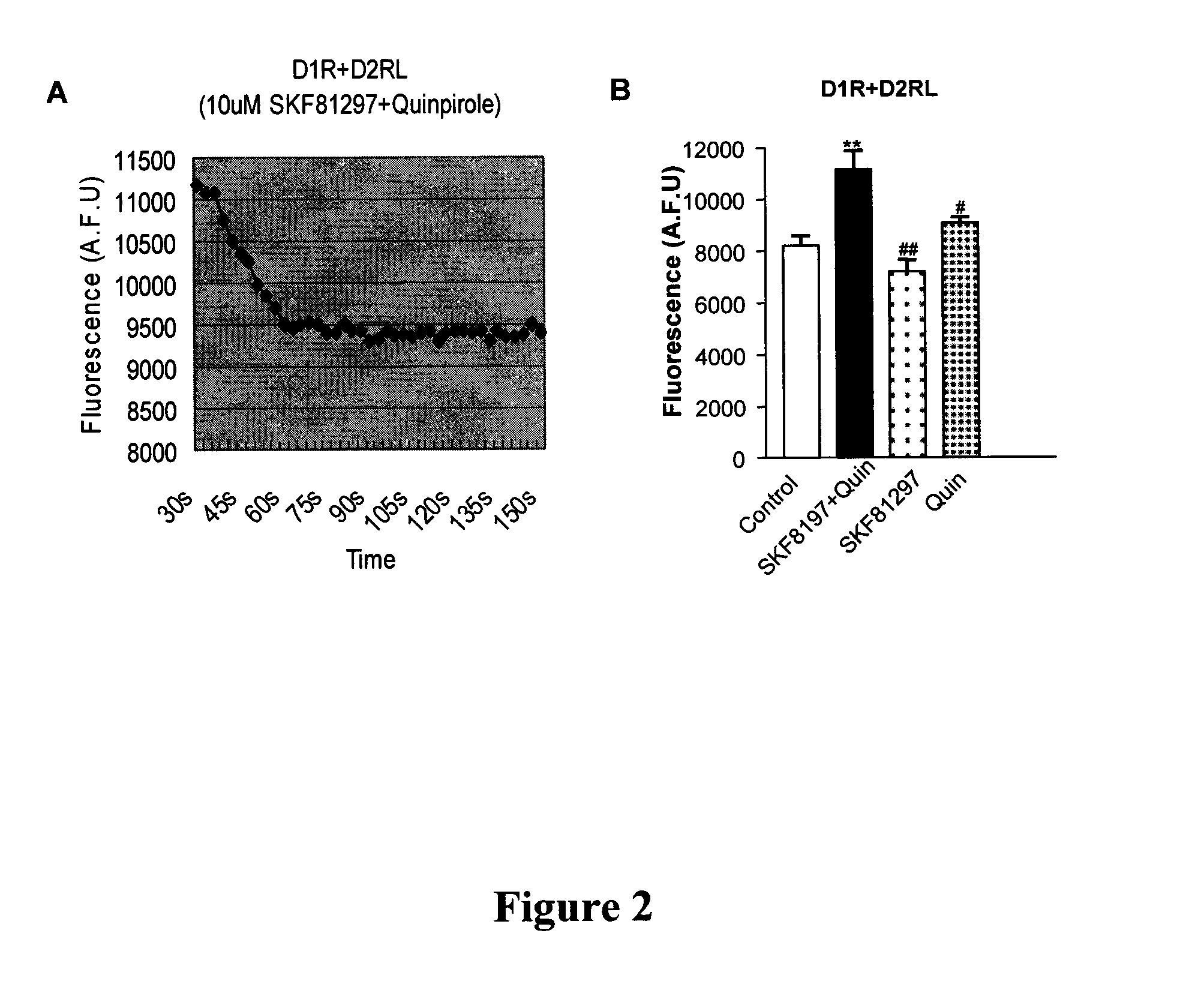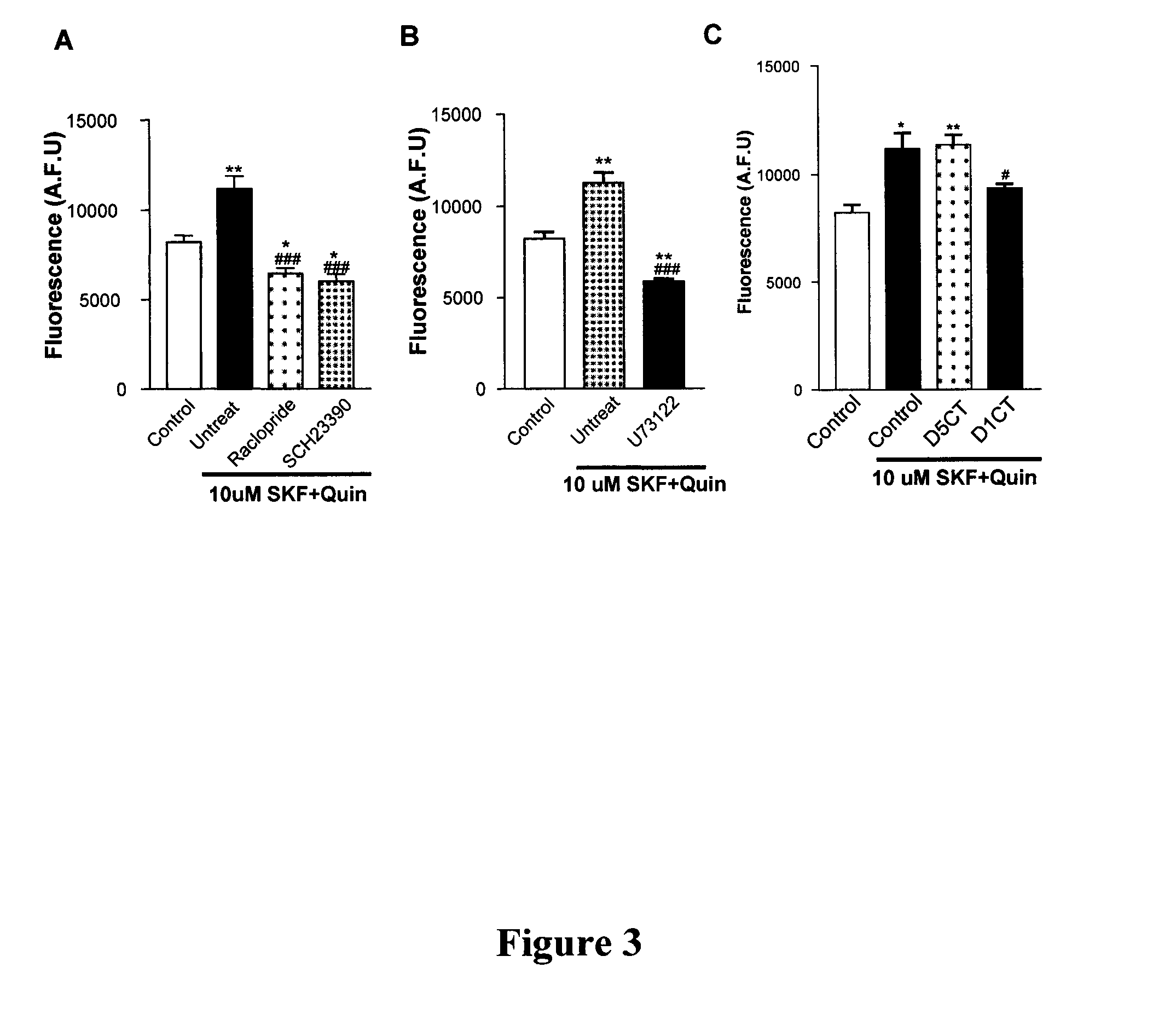Compositions and methods for modulating d1-d2 dopamine receptor interaction and function
a technology of d1-d2 dopamine receptor and interaction and function, which is applied in the direction of neuromedicator receptors, animal/human proteins, sugar derivatives, etc., can solve the problems of affecting the economic impact of depression, causing serious side effects including extrapyramidal side effects, and limited current antipsychotic medications
- Summary
- Abstract
- Description
- Claims
- Application Information
AI Technical Summary
Problems solved by technology
Method used
Image
Examples
experiment 1
D1-D2 Receptor Complex is Facilitated by the D1R Carboxyl Tail (CT) and the Third Intracellular Loop (IL3) of D2R
[0088]To confirm previous reports of a D1-D2 receptor complex we used rat striata in co-immunoprecipitation (co-IP) experiments. As shown in FIG. 1A, the D1R was able to co-precipitate with the D2R, confirming the presence of a D1-D2 receptor complex. In an attempt to define the structural basis for the observed D1-D2 coupling, we carried out affinity purification using GST (glutathione-S-transferase)-fusion proteins encoding the D1CT and the third intracellular loop (D1IL3), since both D1CT: A332-T446 and D1IL3: R219-K272 contain putative consensus sequences for receptor phosphorylation, desensitization and potential binding sites for various proteins important for signalling (e.g. G proteins, NMDA receptor NR1, NR2A subunits)81-82. As shown in FIG. 1B, GST-D1CT, but not GST-D1IL3 or GST alone, precipitated solubilized striatal D2R as illustrated by the D2 antibody immun...
experiment 2
Co-Activation of the D1-D2 Receptor Induces an Increase in Intracellular Ca2+ Mediated by Phospholipase C Activation
[0089]To investigate the functional implication of the D1-D2 coupling, we examined the ability of this complex to promote Gq / 11 signaling as indexed by changes in intracellular Ca2+ levels83-85. In HEK-293T cells co-transfected with D1R and D2R we examined changes in intracellular Ca2+ levels when co-treated with 10 μM SKF81297 and 10 μM quinpirole. Cells that were treated with both agonists exhibited a rapid and significant increase in intracellular Ca2+ levels that peaked 30 seconds after addition of agonists (FIG. 2A). However, cells treated with either SKF81297 or quinpirole alone had no change in Ca2+ levels when compared to nontreated control cells (FIG. 2B). The increase in Ca2+ levels could be blocked by pretreatment with either 10 μM raclopride (D2 antagonist) or 10 μM SCH23390 (D1 antagonist), as shown in FIG. 3A. Furthermore, this unique D1-D2 co-activation ...
experiment 3
Disruption of D1-D2 Coupling Abolished the D1-D2 Co-Activation Induced Increases in Intracellular Ca2+
[0090]Our preliminary data has shown that coexpression of the GST-D1CT is able to affinity pull down the D2R (FIG. 1B). Thus, to test whether D1-D2 coupling is necessary for the D1-D2 co-activation induced increases in intracellular Ca2+, we examined changes in intracellular Ca2+ levels when co-treated with 10 μM SKF81297 and 10 μM quinpirole in HEK-293T cells cotransfected with mini-genes encoding D1CT, D5CT along with D1R and D2R. As shown in FIG. 3C, coexpression of the D1CT mini-gene but not the D5CT mini-gene abolished D1-D2 co-activation induced increases in intracellular Ca2+ suggesting that the D1-D2 coupling may be responsible for the observed increases in intracellular Ca2+ induced by D1 / D2 co-activation.
PUM
| Property | Measurement | Unit |
|---|---|---|
| thermal melting point | aaaaa | aaaaa |
| current | aaaaa | aaaaa |
| height | aaaaa | aaaaa |
Abstract
Description
Claims
Application Information
 Login to View More
Login to View More - R&D
- Intellectual Property
- Life Sciences
- Materials
- Tech Scout
- Unparalleled Data Quality
- Higher Quality Content
- 60% Fewer Hallucinations
Browse by: Latest US Patents, China's latest patents, Technical Efficacy Thesaurus, Application Domain, Technology Topic, Popular Technical Reports.
© 2025 PatSnap. All rights reserved.Legal|Privacy policy|Modern Slavery Act Transparency Statement|Sitemap|About US| Contact US: help@patsnap.com



